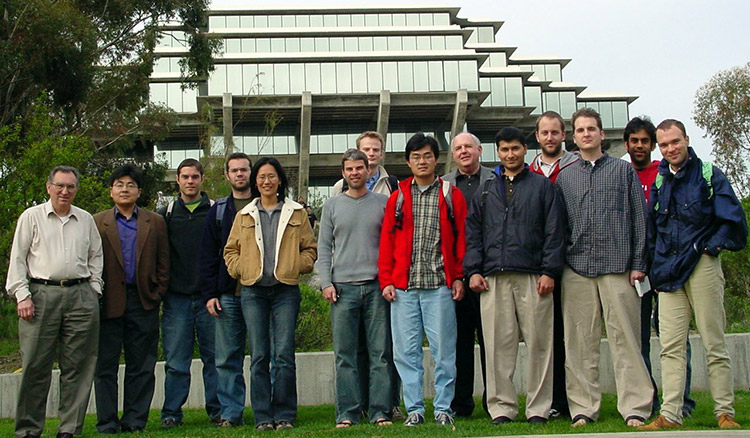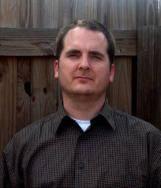
UC San Diego Alumnus Shares in DARPA Spectrum Challenge Grand Prize
Published Date
By:
- Doug Ramsey
Share This:
Article Content

Then-Ph.D. student Alumnus Anderson (third from right) with fellow members of the Pentagon-funded project at UC San Diego led by professor James Zeidler

UC San Diego electrical and computer engineering alumnus Adam Anderson, winner of the DARPA Spectrum Challenge
Adam Anderson is an alumnus of the Electrical and Computer Engineering program in the Jacobs School of Engineering at the University of California, San Diego, where he completed his Ph.D. in 2008. Today he teaches electrical engineering at Tennessee Tech University, and together with a student, Anderson recently pulled off a major coup: winning the Defense Advanced Research Projects Agency (DARPA) Spectrum Challenge. To do so, he developed a radio system that made the best use of broadcast spectrum by automatically seeking wavelengths that aren’t cluttered with radio traffic. These so-called software-defined radios (SDRs) can also adjust output power and transmission parameters and keep track of spectrum use by nearby devices to optimize their performance.
“The potential is there for this to become huge commercially or to enable the military or emergency responders to communicate much more easily in the field,” said Anderson. “Really, the implications of software radios could be huge once it makes it to market phase and the price comes down.”
The UCSD alumnus was quick to give some of the credit to his education and alma mater. “UCSD was an excellent academic experience for me,” recalls Anderson. “It prepared me with both the intellectual skills I needed as well as the desire to succeed.”
"There is a tradition of excellence among ECE alumni, and Adam Anderson is a prime example of what our former students can achieve as researchers, teachers or both," said ECE Chair Shaya Fainman. "The DARPA Spectrum Challenge invited the participation of top teams from across the country, and despite heavy competition, Adam led his team to victory."
The DARPA Spectrum Challenge was a fifteen-month-long competitive demonstration of robust radio technologies. The challenge was to prototype SDRs that could “communicate reliably in congested and contested electromagnetic environments without direct coordination or spectrum preplanning.” DARPA invited teams to design programmable radios that would sense their immediate spectrum environment.
“Those radios then must dynamically and automatically adapt their transmissions to account for dynamic users in dynamic environments,” said DARPA Spectrum Challenge program manager Yiftach Eisenberg. “Here’s the question: Can we design smart radios that figure out how to share spectrum and get signals through without users coordinating first?”
Teams were instructed to transfer the same file between a source radio and a destination radio, with all teams sharing 5 MHz of bandwidth – ensuring that their signals would overlap. Each team used the same set of hardware and data, so the contest hinged on the performance of their software algorithms alone.
According to Anderson, TTU’s winning approach began to take shape in an undergraduate course he was teaching on wireless communications. “After giving a lecture on digital modulation, I asked if any of my students knew what a software-defined radio was,” said Anderson. “One did, so we made a two-man team and entered the competition.”
The Spectrum Challenge was not clear sailing for Anderson and his student partner, Brett Witherspoon. Out of 90 teams that initially registered, 46 completed a rigorous, three-week qualification process out of which DARPA selected the 15 highest-scoring teams, leaving three wildcard slots to be filled last August. “We didn’t qualify at first, but then we passed the wildcard event (barely beating out the UCSD team),” recalled Anderson, noting that TTU had the overall average high score in the wildcard round. “Then in the preliminary competition [which took place in September 2013], we lost the first match but then won nine straight matches to make it to the final round, where we narrowly lost to Vanderbilt.”
That’s where things stood prior to the final competition in 2014, when 15 finalists competed in two separate tournaments: Cooperative, a scenario most applicable to commercial SDR applications; and Competitive, most attuned to military, especially battlefield, applications. Anderson and Witherspoon fell short in the Competitive category, where rivals were free to evade, jam or control their competitors’ signals while managing their environmental obstacles. But Anderson’s team “won it all” in the Cooperative tournament, in which teams had to work together to transmit all three of their files in the shortest time despite environmental obstacles – and without the teams coordinating in advance on how to share the available spectrum.
“The sophistication of the solutions that the teams developed really impressed us,” said DARPA’s Eisenberg. “The teams showed that radios can learn to coexist and communicate reliably by autonomously sensing and adapting to congested electromagnetic environments—paving the way for new spectrum-sharing applications for the Department of Defense and commercial industry.”
Reflecting on the victory, Anderson believes that his team won for two main reasons. “First, we were unique. Almost all other teams went with some sort of OFDM approach with suppressed carriers. We came up with a cool way to both sense the spectrum and then recognize meaningful spectrum without doing any handshaking between radios,” explained Anderson. “The other reason was implementation. My student and I spent hundreds of hours programming on our Linux boxes to get our ideas – ideas that weren’t outlandish – functional. Many teams failed miserably just because they weren’t able to get a good idea working in code.”
It’s not surprising that Anderson excelled in a contest related to wireless spectrum. After earning his undergraduate and Master’s degrees from Brigham Young University, he did his doctoral work at UC San Diego on multiple-input, multiple-output (MIMO) antennas and signal processing, with a dissertation on “Correlation-based Beamforming for Multi-User MIMO Channels.” Anderson was also an ECE peer mentor in his final year at UC San Diego.
As a graduate student researcher, Anderson worked with his advisor James Zeidler on the Department of Defense-funded Multi-University Research Initiative (MURI) project on space-time processing for tactical, mobile, ad-hoc networks, affiliated with the California Institute for Telecommunications and Information Technology (Calit2). Anderson’s own research focused on bridging the gap between physical and medium access control (MAC) layer timescales using linear processing in order to provide cross-layer optimization in the network.
After leaving UC San Diego, Anderson taught at the University of South Florida from 2009 until joining the Tennessee Tech faculty in 2011. In his research, Anderson continued working on MIMO, but with a new focus on massive MIMO systems for big-data networks and communications as well as biomedical devices such as in-body sensors.
He also teaches at both the graduate and undergraduate levels, and Anderson received funding from the university’s Quality Enhancement Program to create a new curriculum for teaching the telecommunications course. “Idea. Design. Build. Publish. Patent,” the blended course, integrates web delivery and video modules in connection with classroom teaching to get more students interested in telecommunications.
Share This:
Stay in the Know
Keep up with all the latest from UC San Diego. Subscribe to the newsletter today.


